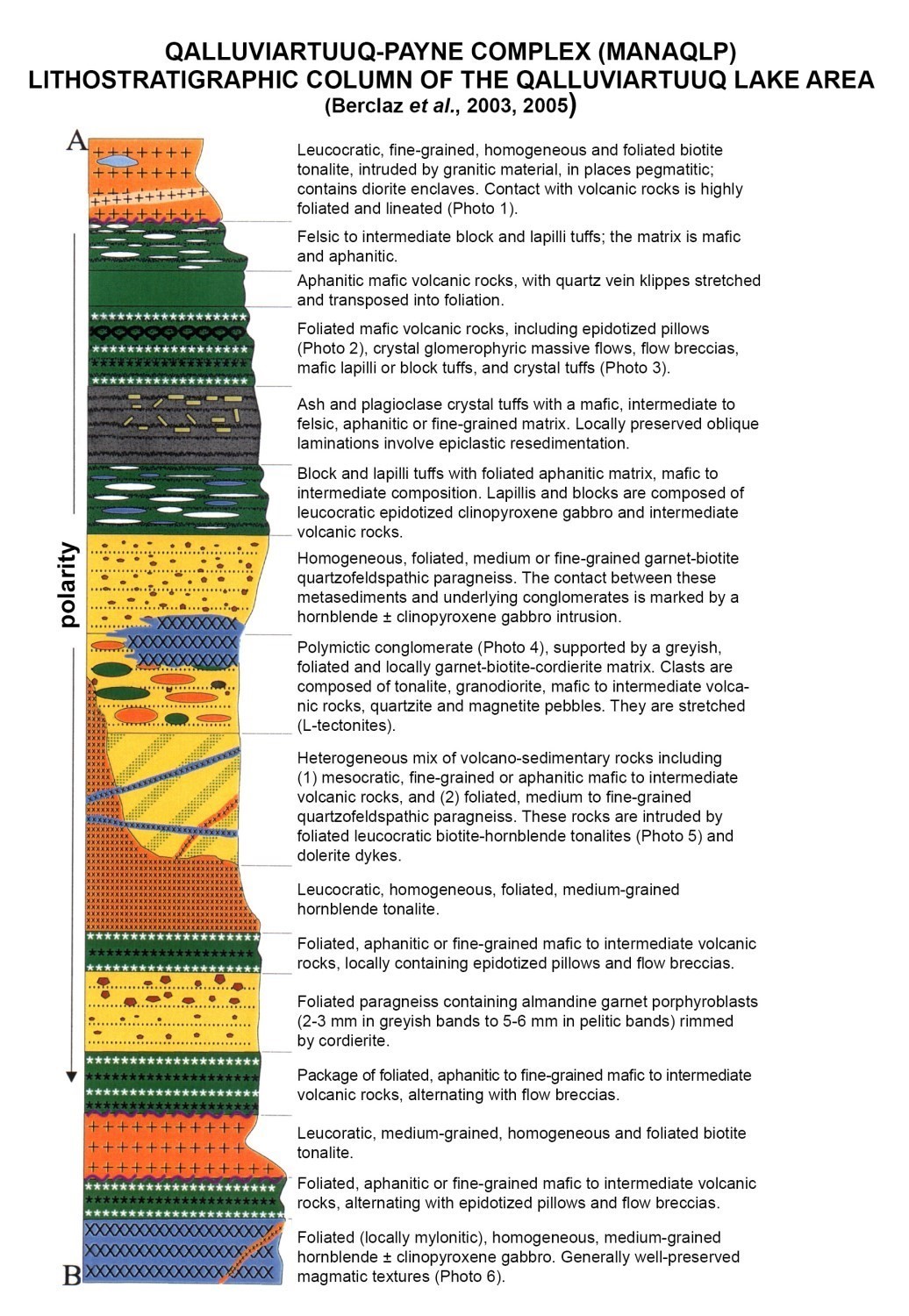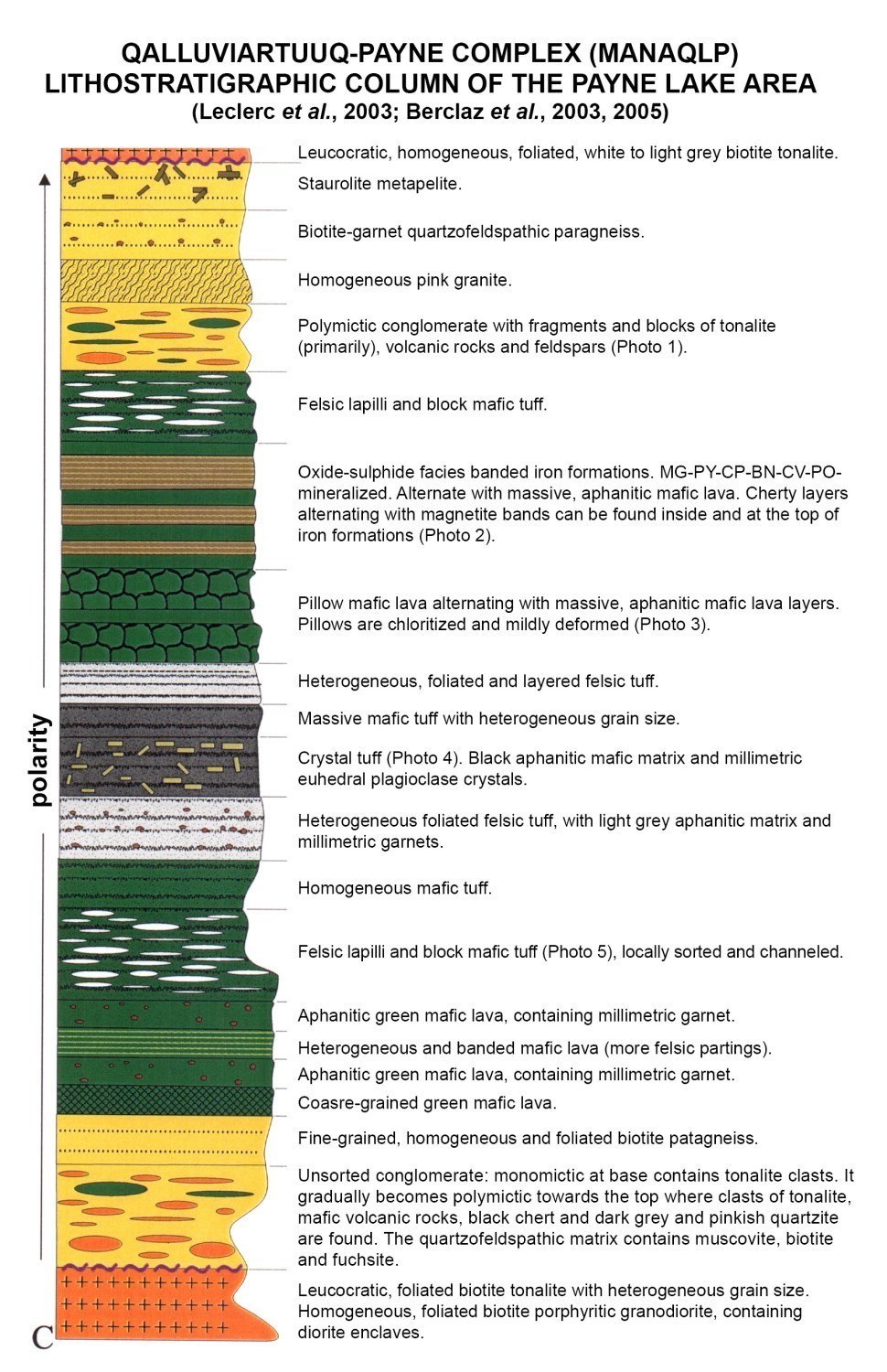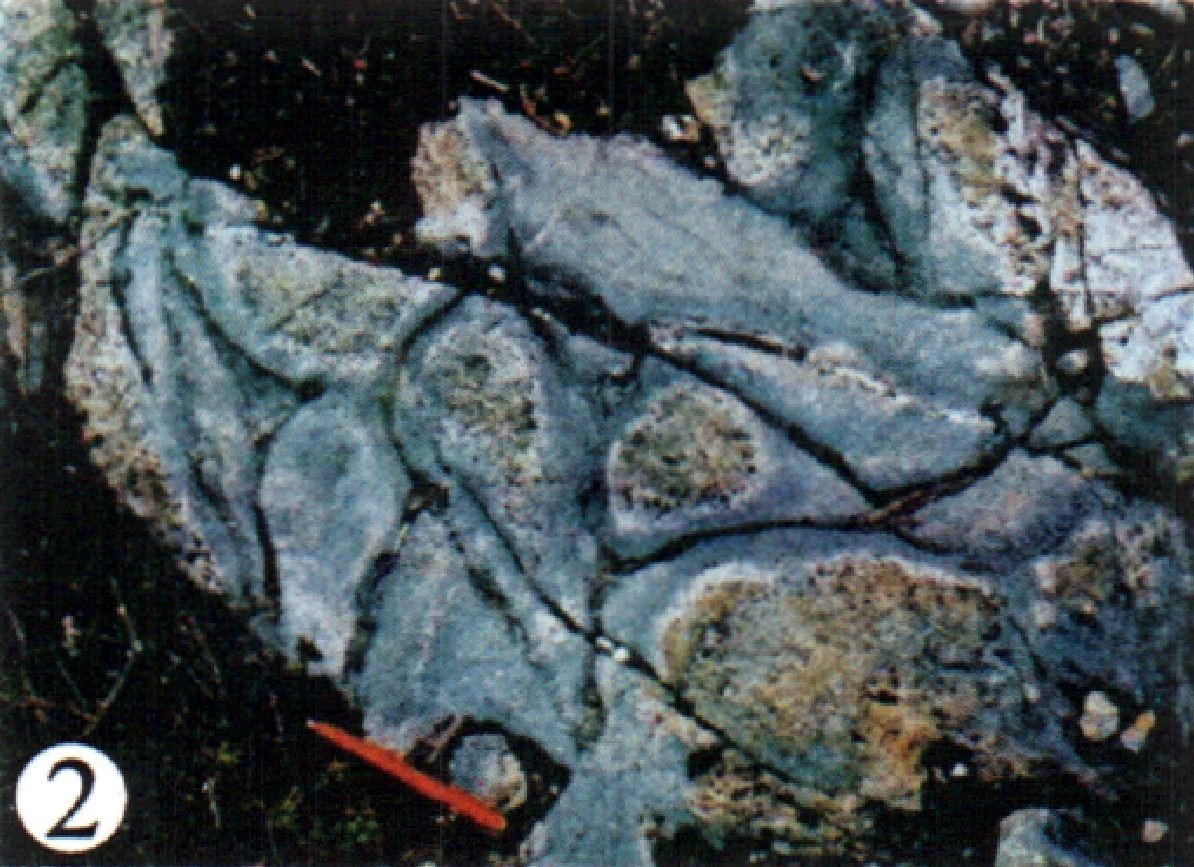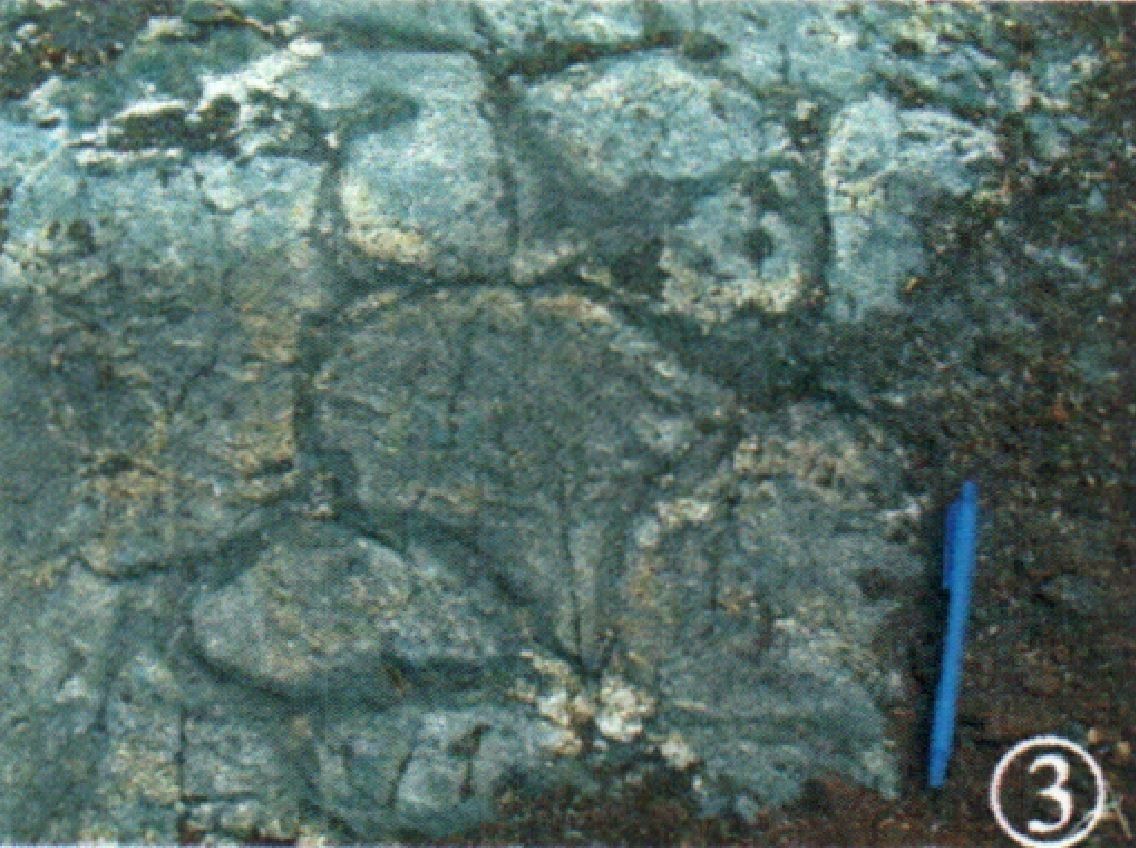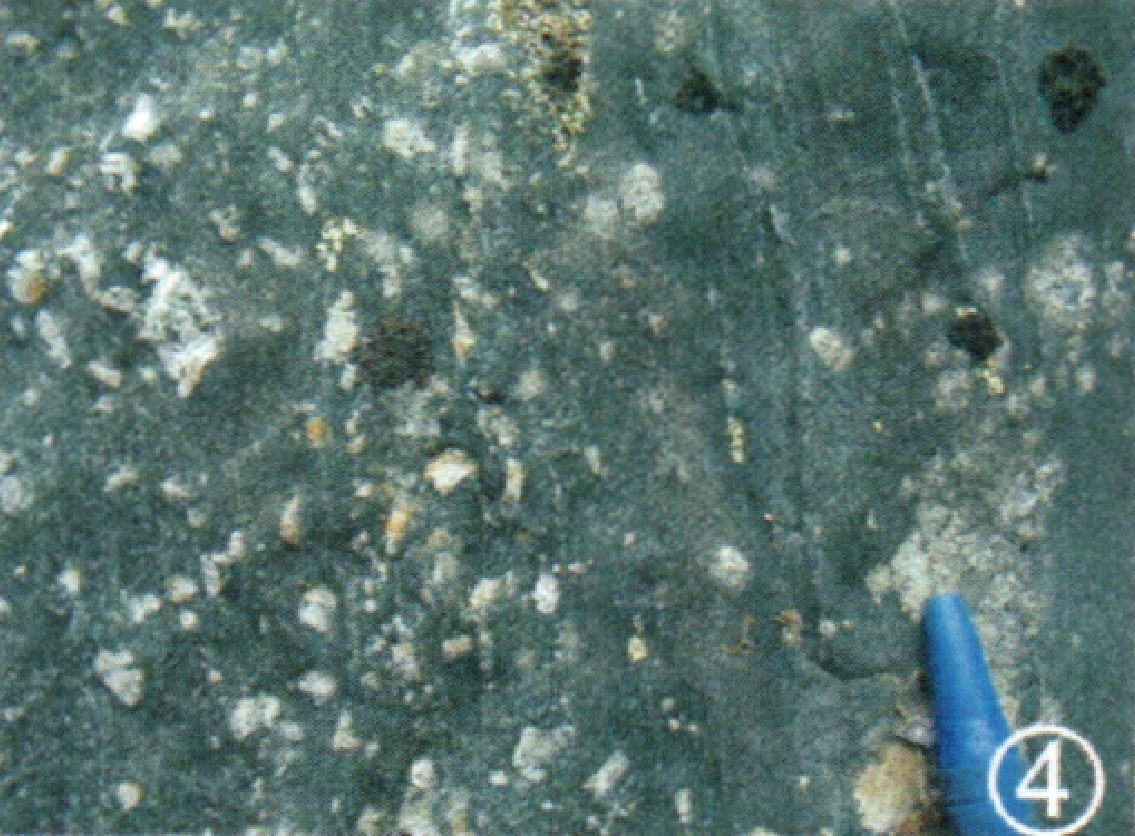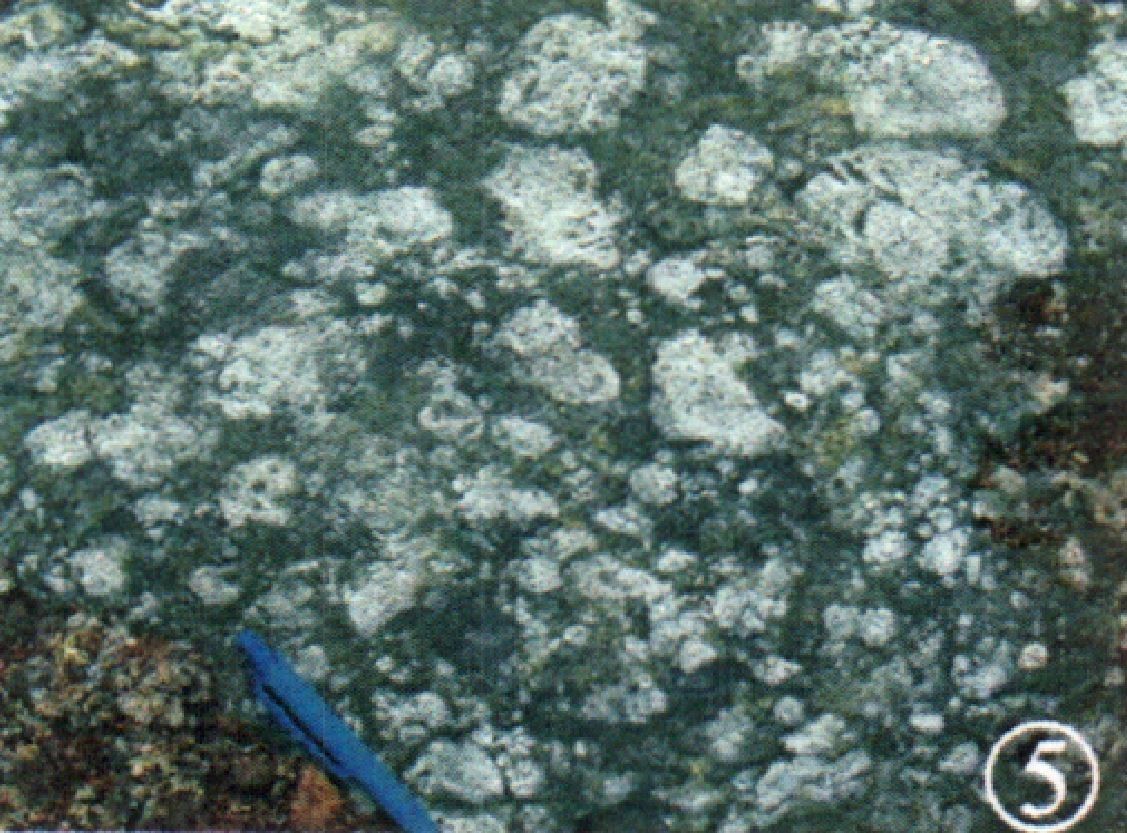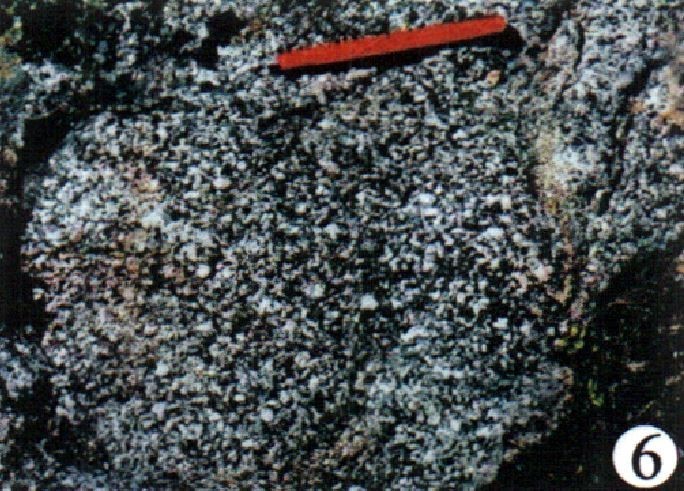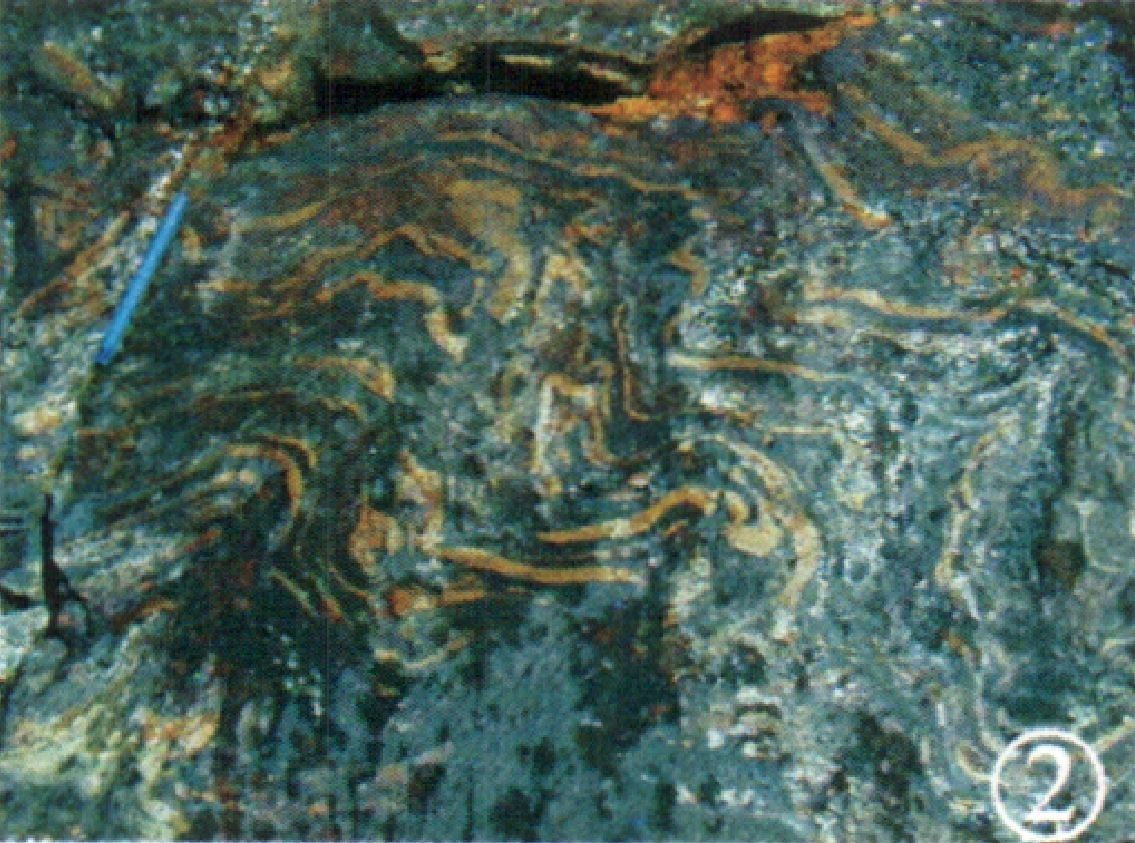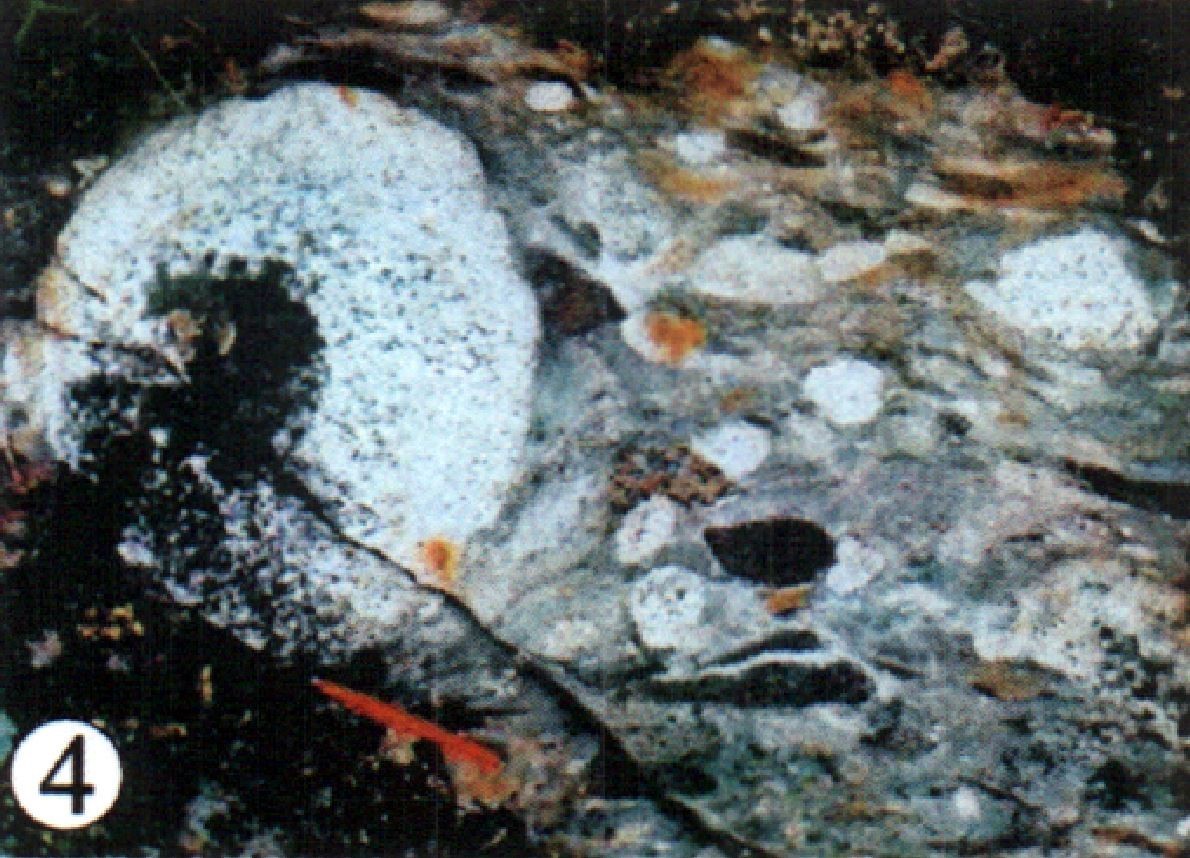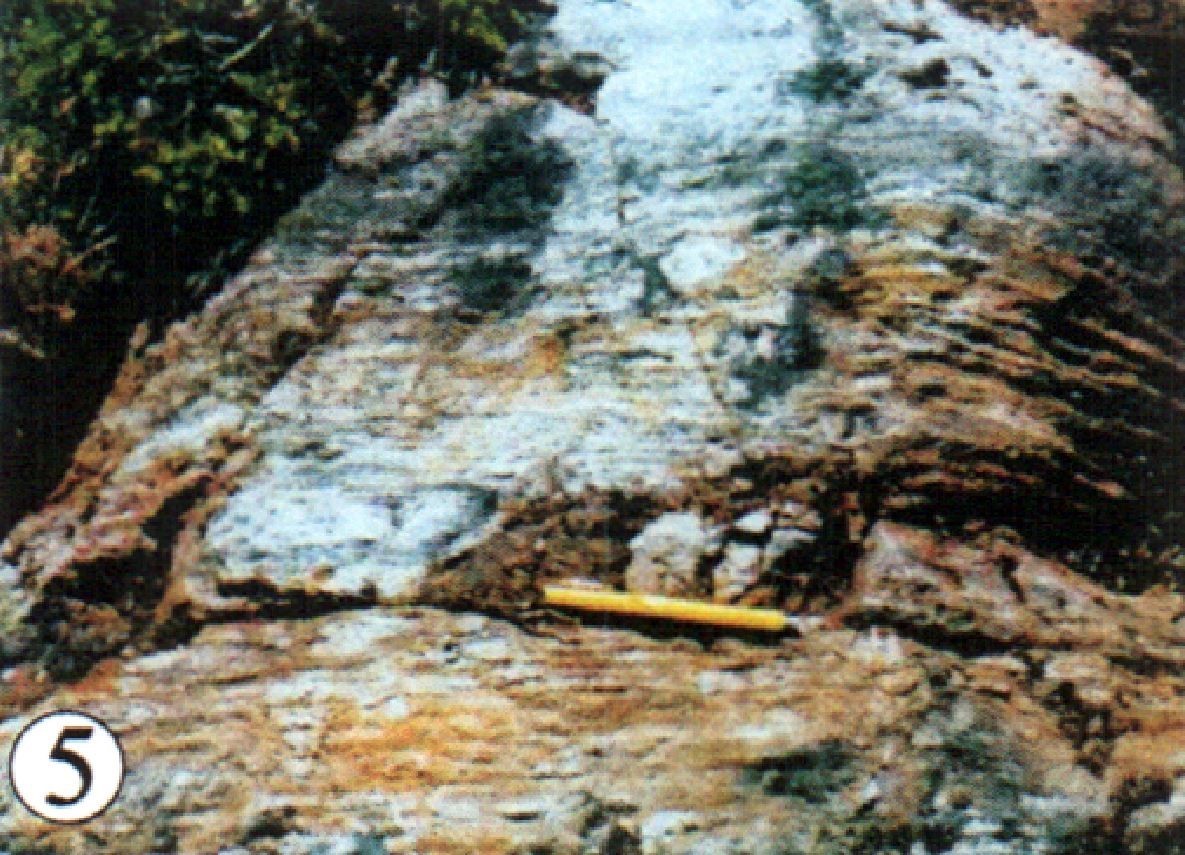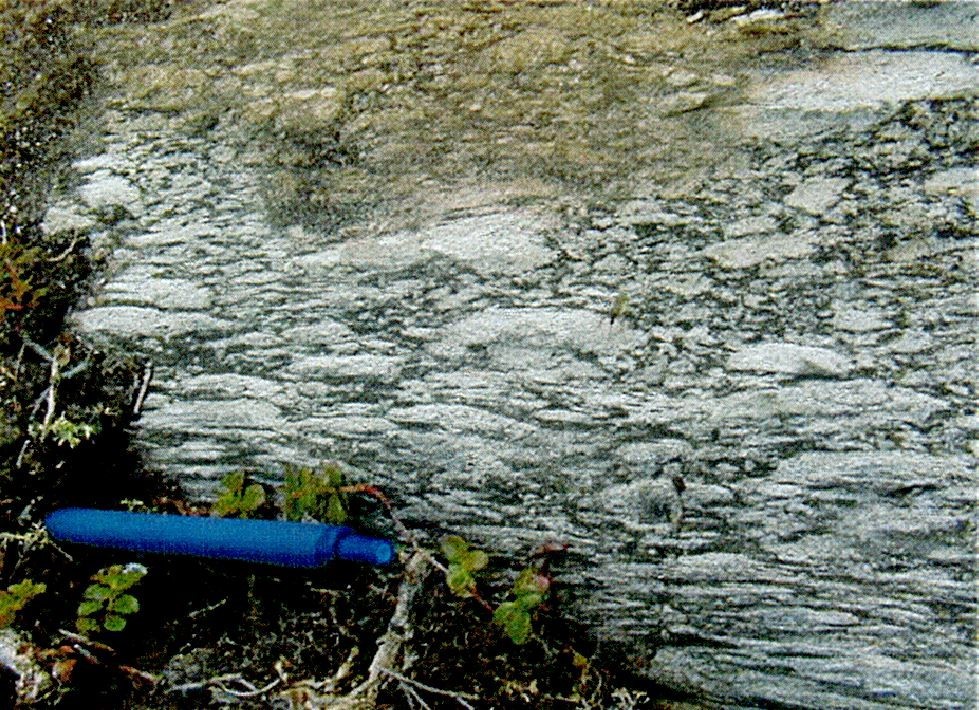
DISCLAIMER: This English version is translated from the original French. In case of any discrepancy, the French version shall prevail.
| Author(s): | Berclaz et al., 2003 |
| Age: | Mesoarchean to Neoarchean |
| Stratotype: | None |
| Type area: | Anuc, Payne and Qalluviartuuq lakes area (NTS sheet 34O) |
| Geological province: | Superior Province |
| Geological subdivision: | Minto Subprovince |
| Lithology: | Volcano-sedimentary rocks |
| Category: | Lithodemic |
| Rank: | Complex |
| Status: | Formal |
| Use: | Active |
None
Background
Percival et al. (1995a) mapped at scale 1:250 000 sequences of volcano-sedimentary rocks in the Kogaluc River (sheet 34N) and Qalluviartuuq and Payne lakes (sheet 34O) area. These rocks were grouped into three belts: the Kogaluc-Tasiat belt, the Payne Lake belt, and the Qalluviartuuq belt (Percival et al., 1995b). In the Anuc Lake area (sheet 34O), Berclaz et al. (2003) combined all volcano-sedimentary rocks of the Qalluviartuuq and Payne Lake belts in the Qalluviartuuq-Payne Complex. In the Vernon Lake and Anuc Lake areas (sheets 34J and 34O), Parent et al. (2002) and Berclaz et al. (2003) grouped supracrustal rocks of the Kogaluc-Tasiat belt into a new unit, the Kogaluc Complex. Subsequently, Simard et al. (2008) included in the Qalluviartuuq-Payne Complex several klippes of volcano-sedimentary rocks metamorphosed to the granulite facies that had been assigned to the eastern part of the Kogaluc Complex by Parent et al. (2002). These klippes are located directly in the southern extension of the Qalluviartuuq-Payne Complex. It is named after Qalluviartuuq and Payne lakes.
Description
The Qalluviartuuq-Payne Complex consists of volcano-sedimentary rock klippes belonging to at least two volcano-sedimentary cycles (Leclerc et al., 2002; Leclerc et al., 2003; Berclaz et al., 2003, 2005; Simard et al., 2008; Simard, 2008). The first volcanic cycle, of tholeiitic affinity, includes massive amphibolite, foliated to banded mafic gneiss, extrusive ultramafic rocks, layered anorthosites and gabbros, as well as intermediate intrusive and extrusive rocks. Cycle 1 rocks are highly recrystallized and metamorphosed to amphibolite and granulite facies.
The second volcanic cycle, of calc-alkaline affinity, consists mainly of mafic to felsic lava and tuff recrystallized to the upper greenschist facies and displaying well-preserved primary textures. It also includes layers of sandstone, argillaceous sandstone, conglomerate and iron formation. In addition to the two volcanic cycles, the complex comprises a significant amount of rocks of sedimentary origin represented by paragneiss accompanied by sandstone, iron formation and polymictic and monomictic conglomerate.
Berclaz et al. (2003, 2005) and the MNRF (2008a-c) divided the Qalluviartuuq-Payne Complex into three informal units that correspond to units mapped by Percival et al. (1995a) in the Kogaluc River and Qalluviartuuq and Payne lakes area. Unit mAnAqlp1 comprises mostly mafic volcanic rocks from both volcanic cycles, as well as intermediate to felsic volcanics (mAnAqlp1a) from Cycle 2, ultramafic metavolcanics (mAnAqlp1b), and gabbro and gabbroic anorthosite (mAnAqlp1c) from Cycle1. Unit mAnAqlp2 consists of migmatitic paragneiss and iron formation associated with Cycle 2, and includes some preserved conglomerate and sandstone beds (mAnAqlp2a). Finally, unit mAnAqlp3 is associated with Cycle 1 and consists of diorite and, locally, meta-andesite.
Qalluviartuuq-Payne Complex 1 (mAnAqlp1) : Mafic to Intermediate Volcanic Rocks
Unit mAnAqlp1 consists of metavolcanic rocks of predominantly mafic to intermediate composition, containing olive-green to brownish green hornblende, plagioclase and locally clinopyroxene, orthopyroxene, biotite, cummingtonite and garnet. The rock is generally dark green and fine to medium grained. Cycle 1 mafic volcanics form homogeneous layers of massive amphibolite or heterogeneous layers of banded and locally very migmatized mafic gneiss. They are metamorphosed to the mid and upper amphibolite facies and are highly transposed and recrystallized. On the contrary, Cycle 2 mafic volcanics are less deformed, metamorphosed to the upper greenschist facies and display remarkably well preserved volcanic textures. The unit also includes mafic and intermediate tuffs, plagioclase porphyritic pillow andesite, dioritic layers, rhyodacite and quartz porphyry rhyodacitic tuff. Cycle 2 volcanic rocks are interstratified with sedimentary rocks.
Qalluviartuuq-Payne Complex 1a (mAnAqlp1a) : Intermediate to Felsic Volcanic Rocks
In Cycle 2, felsic volcanic tuff is present in the Qalluviartuuq Lake area. Foliated and heterogeneous felsic tuff having a light grey aphanitic matrix, and locally millimetric garnet, is present in the area west of Payne Lake (see lithostratigraphic column).
Qalluviartuuq-Payne Complex 1b (mAnAqlp1b) : Ultramafic Metavolcanic Rocks
Unit mAnAqlp1b consists of homogeneous ultramafic metavolcanic rocks, dark green to black in fresh exposure, buff-brown in patina and medium-grained. The rock is mainly composed of olivine and orthopyroxene. A light green amphibole (actinolite, tremolite, cummingtonite) developed preferentially around orthopyroxene grains. Mild foliation is locally well defined by alteration to iddingsite and by small spinel grain streaks. Serpentine and magnetite are abundant in the most deformed rocks, while phlogopite, lepidoblastic chlorite, leucoxene and sulphides are present in minor amounts. The texture of ultramafic volcanics is entirely metamorphic, but their extrusive origin is confirmed by their komatiitic geochemical signature, as well as their spatial association with unit mAnAqlp1 mafic lava and unit mAnAqlp2 paragneiss.
Qalluviartuuq-Payne Complex 1c (mAnAqlp1c) : Gabbro and Gabbroic Anorthosite
Layers of coarse-grained to glomerophyric gabbro and plagioclase gabbroic anorthosite gabbro are interstratified at the base and interior of the Cycle 1 volcanic rocks, particularly in the area of Qalluviartuuq Lake. The rock is white, leucocratic and foliated to mylonitic. Plagioclase megacrystals are associated with interstitial orthopyroxene oikocrystals that give the rock a spotted texture. The mineralogical assemblage also includes interstitial biotite flakes, magnetite, zircon and, locally, hornblende. The rock contains anthophyllite-cordierite altered zones and rust zones with disseminated sulphides. In the Payne Lake area, thin, discontinuous layers of pyroxenite with oikocrysts, anorthositic gabbro intrusions, magnetite-rich peridotite, and ferrogabbro are associated with glomerophyric gabbro. These lithologies display igneous layering.
Qalluviartuuq-Payne Complex 2 (mAnAqlp2) : Migmatitic Paragneiss and Iron Formation
Sedimentary rocks of the Qalluviartuuq-Payne Complex (mAnAqlp2) are dominated by migmatitic quartzofeldsparic paragneiss, which is accompanied by psammite, sandstone, iron formation and conglomerate. The most aluminous beds have developed variable assemblages of garnet, biotite and aluminosilicate (sillimanite, cordierite, staurolite, andalusite, kyanite) that are indicative of (lower to upper) amphibolite facies metamorphism. The rock is grey-brown to rusty brown, leucocratic to mesocratic, heterogeneous and coarse grained (metapelite) or, more locally, melanocratic, homogeneous and fine grained (psammite). It contains 5 to 50% garnet porphyroblastic quartzofeldspathic leucosome. The non-migmatized protolith is composed of varying amounts of quartz, plagioclase, biotite, garnet, muscovite, aluminosilicates and very fine disseminated magnetite.
Paragneiss locally contains metre to decametre-thick (<40 m) iron formation layers, locally associated with volcanic rock units (mAnAqlp1). These layers are generally dismembered, folded and consisting of banded rocks, mainly at the oxide facies, locally at the silicate and sulphide-oxide facies. In thin sections, the rock is foliated, granoblastic and locally displays tectonic banding derived from primary bedding. Oxide facies iron formations consist of millimetric to centimetric bands of magnetite (and amphibole) and recrystallized quartz. Silicate facies iron formations are very siliceous and contain little magnetite. They are distinguished by less continuous banding of felsic and mafic centimetric bands, and by hornblende and/or grunerite porphyroblasts (<2 cm). Felsic bands are composed mainly of quartz and feldspar, while mafic bands contain garnet, biotite, cordierite, sillimanite, hornblende and grunerite in varying amounts. Cordierite and garnet are often poikilitic. Gold mineralization is associated with oxide-sulphide facies iron formations (Labbé and Lacoste, 2001).
Qalluviartuuq-Payne Complex 2a (mAnAqlp2a) : Conglomerate and Sandstone
Polymictic conglomerate (mAnAqlp2a) forms sorted sequences averaging 10 m thick at the interface between intrusive tonalite units and volcano-sedimentary sequences. Polymictic conglomerate is fine grained and has a sandy-pelitic matrix containing fragments and blocks (<25 cm in diameter) of tonalite, granodiorite, mafic to intermediate volcanic rocks, dark grey to pinkish white quartzite, black chert and pyroxenite, and magnetite pebbles. Locally, conglomerate is monomictic, usually coarse grained, containing tonalite lenticular blocks. Polymictic conglomerate would be the result of an intraformational and syndeformation tectonic mélange, while monomictic conglomerate would represent intraformational overlay sequences. Unit mAnAqlp2a contains sandstone and metapelite beds.
Qalluviartuuq-Payne Complex 3 (mAnAqlp3) : Diorite and Meta-Andesite
In areas south of Le Breuil Lake (sheet 34O10) and west of Payne Lake, dioritic rocks (mAnAqlp3) form strips <2 km thick interstratified between mafic volcanics (mAnAqlp1) and paragneiss (mAnAqlp2). These strips correspond to dioritic synvolcanic sills or dykes, or andesites metamorphosed to the amphibolite facies. The rock is homogeneous, granonematolepidoblastic, dark grey, fine to medium grained and foliated. Plagioclase and quartz are locally porphyroclastic. Foliation is highlighted by green hornblende and yellow to green biotite. Epidote grains with allanite cores encompass the whole. The mineralogical assemblage also includes green tourmaline, clinopyroxene and, locally, orthopyroxene.
Thickness and distribution
The Qalluviartuuq-Payne Complex consists of remnants of volcano-sedimentary rocks oriented N-S to NW-SE that span a length of nearly 200 km over a width of <60 km from north of Qalluviartuuq Lake (sheet 34O) to north of Bacqueville Lake (sheets 34J and 34I04). The thickest continuous sequence is between Qalluviartuuq and Pavy lakes, in Sheet 34O.
Dating
U-Pb dating on zircons of anorthosite samples (mAnAqlp1c) yielded crystallization ages of 2851 ±2 Ma (David, 2012) and 2832 ±1.7 Ma (Skulski et al., 1996). A U-Pb age of 2841 +4/-3 Ma was obtained in a dyke of intermediate composition (Percival et al., 1997) and a U-Pb age on inherited zircons of 2836 ±1.5 Ma was obtained in a dioritic dyke (mAnAqlp3) cutting pillow lava (Skulski et al., 1996). Detrital zircons collected from a biotite-quartz schist derived from a rhyolitic tuff (sample PBAS-95-1095) located west of Payne Lake (mAnAqlp1a) yielded U-Pb ages of 2840 ±20 Ma, 2823 ±4 Ma, 2770 ±5 Ma and 2748 ±6 Ma (Skulski, unpublished data). Finally, U-Pb zircon ages of 2849 ±4 Ma (sample 01-FL-6004A; David, 2012), 2831 ±1 Ma (Skulski et al., 1996) and 2809 +2/-1 Ma (Percival and Skulski, 2000) were obtained in tonalites associated with volcano-sedimentary rocks of the Qalluviartuuq-Payne Complex.
Metamorphic ages on monazites of 2702 ±1 Ma in a garnet-sillimanite paragneiss, 2688 ±1 Ma and 2673 +2/-1 Ma in a kyanite-sillimanite schist and 2648.2 ±1.4 Ma in a staurolite schist were obtained for unit mAnAqlp2 (Percival and Skulski, 2000).
| Unit | Sample Number | Isotopic System | Mineral | Crystallization Age (Ma) | (+) | (-) | Inherited Age (Ma) | (+) | (-) | Metamorphic Age (Ma) | (+) | (-) | Reference(s) |
| mAnAqlp1c | 2001-AB-067-A1 | U-Pb | Zircon | 2851 | 2 | 2 | David, 2012 | ||||||
| QAN92 | U-Pb | Zircon | 2832 | 1.7 | 1.7 | Skulski et al., 1996 | |||||||
| mAnAqlp3 | PBAW-94-293 | U-Pb | Zircon | 2836 | 1.5 | 1.5 | Skulski et al., 1996 | ||||||
| mAnAqlp2 | PBA-94-255 | U-Pb | Monazite | 2702 | 1 | 1 | Percival et Skulski, 2000 | ||||||
| PBA-94-618 | U-Pb | Monazite |
2688 2673 |
1 2 |
1 1 |
Percival and Skulski, 2000 | |||||||
| PBA-95-1477 | U-Pb | Monazite | 2648.2 | 1.4 | 1.4 | Percival and Skulski, 2000 |
Stratigraphic Relationship(s)
It is possible that rocks of the first volcanic cycle of the Qalluviartuuq-Payne Complex and the Duquet Complex further north are equivalent (Simard, 2008). Volcano-sedimentary rocks of calc-alkaline affinity from the second cycle of the Qalluviartuuq-Payne Complex may be equivalent to volcano-sedimentary rocks of the Kogaluc Complex, which have an estimated mean age of 2760 Ma (Simard et al., 2008). This hypothesis is supported by dating of a fragment contained in a conglomerate of the Qalluviartuuq-Payne Complex (Percival and Skulski, 2000). Furthermore, the boundary between the Kogaluc and Qalluviartuuq-Payne complexes is imprecise, since several small volcano-sedimentary rock klippes located between these two units could belong to either complex (Simard, 2008).
To the north, east and partly south, volcano-sedimentary units of the Qalluviartuuq-Payne Complex are hosted in tonalitic (Rochefort Suite) or granitic (La Chevrotière Suite) intrusive rocks (Berclaz et al., 2003). To the west and south, they are in contact with enderbitic-charnockitic-type rocks (MacMahon and Lac Minto suites).
Paleontology
Does not apply.
References
Publications available through SIGÉOM Examine
BERCLAZ, A., MAURICE, C., LACOSTE, P., DAVID, J., LECLERC, F., SHARMA, K.N.M., LABBE, J Y., GOULET, N., BEDARD, J., VALLIERES, J. 2003. GEOLOGIE DE LA REGION DU LAC ANUC (34O). MRN. RG 2002-14, 60 pages and 1 plan.
BERCLAZ, A., MAURICE, C., LACOSTE, P., DAVID, J., LECLERC, F., SHARMA, K N M., LABBE, J Y., GOULET, N., BEDARD, J., VALLIERES, J. 2005. GEOLOGY OF THE LAC ANUC AREA (34O). MRNF. RG 2003-05, 55 pages and 1 plan.
DAVID, J. 2012. DATATIONS ISOTOPIQUES EFFECTUEES DANS LE NORD-EST DE LA PROVINCE DU SUPRERIEUR (TRAVAUX DE 2001, 2002 ET 2003). MRNF. DV 2012-05, 84 pages.
LABBE, J Y., LACOSTE, P. 2001. ENVIRONNEMENTS PROPICES AUX MINERALISATIONS POLYMETALLIQUES DE TYPE VOLCANOGENE DANS LE GRAND-NORD QUEBECOIS. MRN. MB 2001-07, 83 pages.
LECLERC, F., GOULET, N., BERCLAZ, A. 2002. ÉVOLUTION TECTONOSTRATIGRAPHIQUE DE LA CEINTURE VOLCANO-SÉDIMENTAIRE DE QALLUVIARTUUQ – PAYNE. In : LECLAIR, A. 2002. PROJET DE CARTOGRAPHIE DU GRAND-NORD – RAPPORT D’ATELIER. MRN. MB 2002-01, 72 pages.
LECLERC, F., GOULET, N., BERCLAZ, A., MAURICE, C. 2003. ÉVOLUTION TECTONOSTRATIGRAPHIQUE ET MÉTAMORPHIQUE DE LA CEINTURE VOLCANOSÉDIMENTAIRE DE QALLUVIARTUUQ-PAYNE : NOUVELLES PERSPECTIVES. In : LECLAIR, A. 2003. PROJET DE CARTOGRAPHIE DU GRAND-NORD – RAPPORT D’ATELIER. MRN. MB 2003-01, 91 pages.
MRNF 2008a. COMPILATION GEOLOGIQUE 1/250 000, 34I – LAC LA POTHERIE. In : MRNF. 2010. CARTE(S) GÉOLOGIQUE(S) DU SIGEOM – feuillet 34I. CG SIGEOM34I, 1 plan.
MRNF 2008b. COMPILATION GEOLOGIQUE 1/250 000, 34J – LAC VERNON. In : MRNF. 2010. CARTE(S) GÉOLOGIQUE(S) DU SIGEOM – feuillet 34J. CG SIGEOM34J, 1 plan.
MRNF 2008c. COMPILATION GEOLOGIQUE 1/250 000, 34O – LAC ANUC. In : MRNF. 2010. CARTE(S) GÉOLOGIQUE(S) DU SIGEOM – feuillet 34O. CG SIGEOM34O, 1 plan.
PARENT, M., LECLAIR, A., DAVID, J., SHARMA, K.N.M., LACOSTE, P. 2002. GEOLOGIE DE LA REGION DU LAC VERNON (34J). MRN. RG 2001-11, 44 pages and 1 plan.
PARENT, M., LECLAIR, A., DAVID, J., SHARMA, K N M., LACOSTE, P. 2003. GEOLOGY OF THE LAC VERNON AREA (34J). MRN. RG 2002-07, 40 pages and 1 plan.
SIMARD, M. 2008. LEXIQUE STRATIGRAPHIQUE DES UNITES ARCHEENNES DU NORD-EST DE LA PROVINCE DU SUPERIEUR. MRNF. DV 2008-03, 107 pages.
SIMARD, M., LABBE, J Y., MAURICE, C., LACOSTE, P., LECLAIR, A., BOILY, M. 2008. SYNTHESE DU NORD-EST DE LA PROVINCE DU SUPERIEUR. MRNF. MM 2008-02, 198 pages and 8 plans.
Other publications
PERCIVAL, J.A., SKULSKI, T. 2000. TECTONOTHERMAL EVOLUTION OF THE NORTHERN MINTO BLOCK, SUPERIOR PROVINCE, QUEBEC, CANADA. The Canadian Mineralogist; volume 38, pages 345-378. https://doi.org/10.2113/gscanmin.38.2.345
PERCIVAL, J.A., SKULSKI, T., CARD, K.D., LIN, S. 1995a. Geology, Rivière Kogaluc-Lac Qalluviartuuq region (parts of 34J and 34-O), Quebec; Geologique Survey of Canada, Open File 3112, 1 1:50 000 map. https://doi.org/10.4095/205269
PERCIVAL, J.A., SKULSKI, T., LIN, S., CARD, K.D. 1995b. Granite-greenstone terranes of the northern Goudalie domain, northeastern Superior Province, Quebec. In : Canadian Shield / Bouclier canadien; Geological Survey of Canada, Curent Research 1995-C, pages 141-150. https://doi.org/10.4095/202913
PERCIVAL, J.A., SKULSKI, T., NADEAU, L. 1997. Granite-greenstone terranes for the northern Minto block, northeastern Quebec: Pelican-Nantais, Faribault-Leridon, and Duquet belts. In : Canadian Shield / Bouclier canadien; Geological Survey of Canada, Curent Research 1997-C, pages 201-210. https://doi.org/10.4095/208646
SKULSKI, T., PERCIVAL, J.A., STERN, R.A. 1996. Archean crustal evolution in the central Minto block, northern Quebec. In : Radiogenic age and isotopic studies: Report 9; Geological Survey of Canada, Curent Research 1995-F, pages 17-31. https://doi.org/10.4095/207760
Suggested Citation
Ministère de l’Énergie et des Ressources naturelles (MERN). Qalluviartuuq-Payne Complex. Quebec Stratigraphic Lexicon. https://gq.mines.gouv.qc.ca/lexique-stratigraphique/province-du-superieur/complexe-de-qalluviartuuq-payne_en [accessed on Day Month Year].
Contributors
|
First publication |
Céline Dupuis, P. Geo., Ph.D. celine.dupuis@mern.gouv.qc.ca (redaction, French and English versions) Mehdi A. Guemache, P. Geo., Ph.D. (coordination); Charles St-Hilaire, GIT, M.Sc. (critical review and editing); Ricardo Escobar Moran (HTML editing). |


